Socioeconomic Impacts of University–Industry Collaborations–A Systematic Review and Conceptual Model
Abstract
1. Introduction
2. Materials and Methods
2.1. CIMO Analysis
2.2. Planning (Stage 1)
2.3. Conducting (Stage 2)
3. Results
Descriptive Analysis
4. Discussion
4.1. Context
4.2. Interventions
4.3. Mechanisms
4.4. Outcomes
5. Conclusions
5.1. Theoretical Contributions
5.2. Managerial Contributions
5.3. Research Limitations
5.4. Future Research Directions
Author Contributions
Funding
Institutional Review Board Statement
Informed Consent Statement
Data Availability Statement
Acknowledgments
Conflicts of Interest
Appendix A
| Author | Articles | Year |
|---|---|---|
| David Urbano | 4 | 2013, 2016 (2) and 2019 |
| Albert Link | 3 | 2013 (2) and 2015 |
| Christopher Hayter | 3 | 2013 (2) and 2015 |
| David Audretsch | 3 | 2009, 2013, and 2019 |
| Erik Lehmann | 3 | 2015, 2018, and 2019 |
| Matthias Menter | 3 | 2015, 2018, and 2019 |
| Maribel Guerrero | 3 | 2013, 2016, and 2019 |
| Henry Etzkowitz | 2 | 2005 and 2013 |
| Maryann Feldman | 2 | 2006 and 2012 |
| Iryna Lendel | 2 | 2010 and 2016 |
| Andrés Barge-Gil | 2 | 2010 and 2011 |
| Aurelia Mondrego | 2 | 2010 and 2011 |
| Helen Lawton Smith | 2 | 2003 and 2012 |
| Peter Nijkamp | 2 | 2007 and 2014 |
| Joaquín Azagra-Caro | 2 | 2017 and 2019 |
| Elena Tur | 2 | 2017 and 2019 |
| Magnus Klofsten | 2 | 1999 and 2019 |
| Alain Fayolle | 2 | 2016 and 2019 |
| Country | Participation (Number of Publications) | Percentage (%) |
|---|---|---|
| United States | 25 | 26.60 |
| United Kingdom | 15 | 15.96 |
| Spain | 12 | 12.77 |
| Germany | 8 | 8.51 |
| Italy | 8 | 8.51 |
| The Netherlands | 8 | 8.51 |
| Sweden | 5 | 5.32 |
| Norway | 4 | 4.26 |
| Australia | 3 | 3.19 |
| Canada | 3 | 3.19 |
| Portugal | 3 | 3.19 |
| South Korea | 3 | 3.19 |
| Austria | 2 | 2.13 |
| Belgium | 2 | 2.13 |
| Brazil | 2 | 2.13 |
| Denmark | 2 | 2.13 |
| Mexico | 2 | 2.13 |
| Russia | 2 | 2.13 |
| South Africa | 2 | 2.13 |
| Spain | 2 | 2.13 |
| Taiwan | 2 | 2.13 |
| Argentina | 1 | 1.06 |
| China | 1 | 1.06 |
| Colombia | 1 | 1.06 |
| Costa Rica | 1 | 1.06 |
| Croatia | 1 | 1.06 |
| Czech Republic | 1 | 1.06 |
| Estonia | 1 | 1.06 |
| France | 1 | 1.06 |
| India | 1 | 1.06 |
| Indonesia | 1 | 1.06 |
| Ireland | 1 | 1.06 |
| Japan | 1 | 1.06 |
| Lithuania | 1 | 1.06 |
| Malaysia | 1 | 1.06 |
| Nigeria | 1 | 1.06 |
| Singapore | 1 | 1.06 |
| South Africa | 1 | 1.06 |
Appendix B
| Authors and Year | Citations | Dominating Mechanisms |
|---|---|---|
| Ahrweiler et al. (2011) [28] | 189 | Spin-offs |
| Alessandrini et al. (2013) [8] | 27 | Intellectual property |
| Aparicio et al. (2016) [60] | 40 | Consulting and hiring professionals with academic knowledge |
| Audretsch et al. (2013) [29] | 37 | Intellectual property |
| Audretsch et al. (2019) [6] | 131 | Spin-offs and intellectual property |
| Azagra-Caro et al. (2017) [36] | 81 | Intellectual property |
| Azagra-Caro et al. (2019) [61] | 9 | Sponsored research |
| Barge-gil and Modrego (2011) [23] | 107 | Hybrid organizations |
| Baskaran et al. (2019) [62] | 4 | Hybrid organizations |
| Bercovitz and Feldman (2006) [9] | 1070 | All mechanisms |
| Bradley et al. (2013) [30] | 72 | Hybrid organizations |
| Bramwell and Wolfe (2008) [25] | 771 | Intellectual property |
| Breznitz and Feldman (2012) [19] | 267 | Intellectual property |
| Budyldina (2018) [20] | 54 | Spin-offs and intellectual property |
| Carayannis et al. (2017) [63] | 54 | Consulting and hiring professionals with academic knowledge |
| Carlsson et al. (2009) [64] | 276 | Spin-offs and intellectual property |
| Chang et al. (2006) [57] | 62 | Spin-offs and intellectual property |
| Chen et al. (2016) [51] | 13 | Sponsored research |
| Cheshire and Magrini (2000) [65] | 233 | Consulting and hiring professionals with academic knowledge |
| Chiesa and Piccaluga (2000) [42] | 546 | Spin-offs |
| Civera et al. (2019) [66] | 18 | Spin-offs |
| Coronado et al. (2017) [27] | 4 | Intellectual property |
| Dalmarco et al. (2018) [67] | 65 | Spin-offs and intellectual property |
| Dill (1995) [68] | 202 | All mechanisms |
| Doh and Kim (2014) [24] | 285 | Intellectual property |
| Dutrénit and Arza (2010) [32] | 121 | All mechanisms |
| Etzkowitz (2013) [21] | 278 | All mechanisms |
| Etzkowitz et al. (2005) [3] | 490 | Hybrid organizations |
| Fadeyi et al. (2019) [69] | 4 | Spin-offs and intellectual property |
| Farinha et al. (2016) [70] | 92 | Sponsored research |
| Fernandes et al. (2010) [55] | 143 | All mechanisms |
| Fischer et al. (2018) [71] | 10 | Hybrid organizations and intellectual property |
| Galan-Muros and Davey (2019) [5] | 66 | Sponsored research |
| Gjelsvik (2018) [72] | 10 | Spin-offs and intellectual property |
| Guadix et al. (2016) [43] | 63 | Hybrid organizations |
| Guerrero et al. (2016) [73] | 174 | Spin-offs and intellectual property |
| Handoko et al. (2014) [74] | 46 | Consulting and hiring professionals with academic knowledge |
| Hayter (2013) [75] | 112 | Spin-offs |
| Hayter and Link (2015) [56] | 48 | Hybrid organizations |
| Hearn et al. (2004) [76] | 54 | Spin-offs and intellectual property |
| Holley and Harris (2018) [52] | 15 | Spin-off and sponsored research |
| Hooi and Wang (2019) [77] | 2 | Spin-offs and intellectual property |
| Hope (2016) [34] | 16 | Intellectual property and publications |
| Iacobucci and Micozzi (2015) [78] | 90 | Spin-offs |
| Jones and De Zubielqui (2017) [40] | 61 | Consulting and hiring professionals with academic knowledge |
| Jones-Evans et al. (1999) [79] | 257 | Hybrid organizations |
| Kalantaridis (2019) [80] | 3 | Intellectual property |
| Kim et al. (2012) [81] | 151 | Spin-offs |
| Klofsten et al. (2019) [82] | 101 | Hybrid organizations |
| Kochetkov et al. (2017) [37] | 15 | Spin-offs |
| Kourtit et al. (2014) [53] | 2 | Spin-offs and hybrid organizations |
| Langford et al. (2006) [83] | 173 | Sponsored research |
| Lee (2019) [84] | 7 | Intellectual property |
| Lehmann and Menter (2016) [85] | 60 | All mechanisms |
| Lehmann and Menter (2017) [86] | 40 | Intellectual property |
| Lendel (2010) [26] | 104 | Spin-offs |
| Lendel and Qian (2017) [35] | 8 | Consulting and hiring professionals with academic knowledge |
| Lin (2019) [87] | 2 | Intellectual property |
| Looy et al. (2003) [88] | 203 | Spin-offs |
| Macpherson and Ziolkowski (2005) [48] | 37 | Hybrid organizations |
| Mariani, Carlesi and Scarfò (2018) [89] | 21 | Spin-offs |
| Mascarenhas et al. (2019) [90] | 7 | Intellectual property |
| Mccullough (2003) [91] | 7 | All mechanisms |
| Mets et al. (2016) [39] | 9 | Intellectual property |
| Ndonzuau et al. (2002) [92] | 665 | Spin-offs |
| Núñez-sánchez et al. (2012) [93] | 25 | Sponsored research |
| O’shea et al. (2008) [44] | 574 | Spin-offs |
| Olmos-peñuela et al. (2014) [47] | 142 | Consulting and hiring professionals with academic knowledge |
| Onken et al. (2019) [94] | 1 | Intellectual property |
| Orozco and Ruiz (2010) [54] | 35 | All mechanisms |
| Owusu-Agyeman and Fourie-Malherbe (2019) [38] | 2 | Sponsored research |
| Perkmann et al. (2015) [33] | 62 | Intellectual property |
| Philbin (2008) [22] | 52 | All mechanisms |
| Piirainen et al. (2016) [45] | 39 | All mechanisms |
| Raguž and Mehičić (2017) [95] | 3 | Intellectual property |
| Ramos-Vielba and Fernández-Esquinas (2012) [46] | 93 | Spin-offs and intellectual property |
| Ratinho and Henriques (2010) [96] | 413 | Hybrid organizations |
| Roessner et al. (2013) [97] | 96 | Intellectual property |
| Sá et al. (2019) [98] | 27 | Sponsored research |
| Sánchez-Barrioluengo and Benneworth (2019) [99] | 61 | Sponsored research |
| Secundo et al. (2017) [41] | 115 | Spin-offs and intellectual property |
| Sherman and Chappell (1998) [100] | 267 | Hybrid organizations |
| Sizer (2001) [101] | 58 | Spin-offs and intellectual property |
| Smith (2003) [102] | 145 | Hybrid organizations |
| Smith and Bagchi-Sem (2012) [58] | 157 | Spin-offs and intellectual property |
| Steffensen et al. (2000) [49] | 700 | Spin-offs |
| Urbano and Guerrero (2013) [50] | 297 | Spin-offs |
| Van Geenhuizen et al. (2007) [103] | 4 | Hybrid organizations and spin-offs |
| Varga (2000) [104] | 662 | Spin-offs and intellectual property |
| Villasana (2011) [105] | 27 | Hybrid organizations |
| Vincett (2010) [106] | 139 | Spin-offs |
| Wakkee et al. (2019) [107] | 31 | Sponsored research |
| Wen and Kobayashi (2001) [108] | 91 | Sponsored research |
| Zucker and Darby (2001) [109] | 443 | Intellectual property |
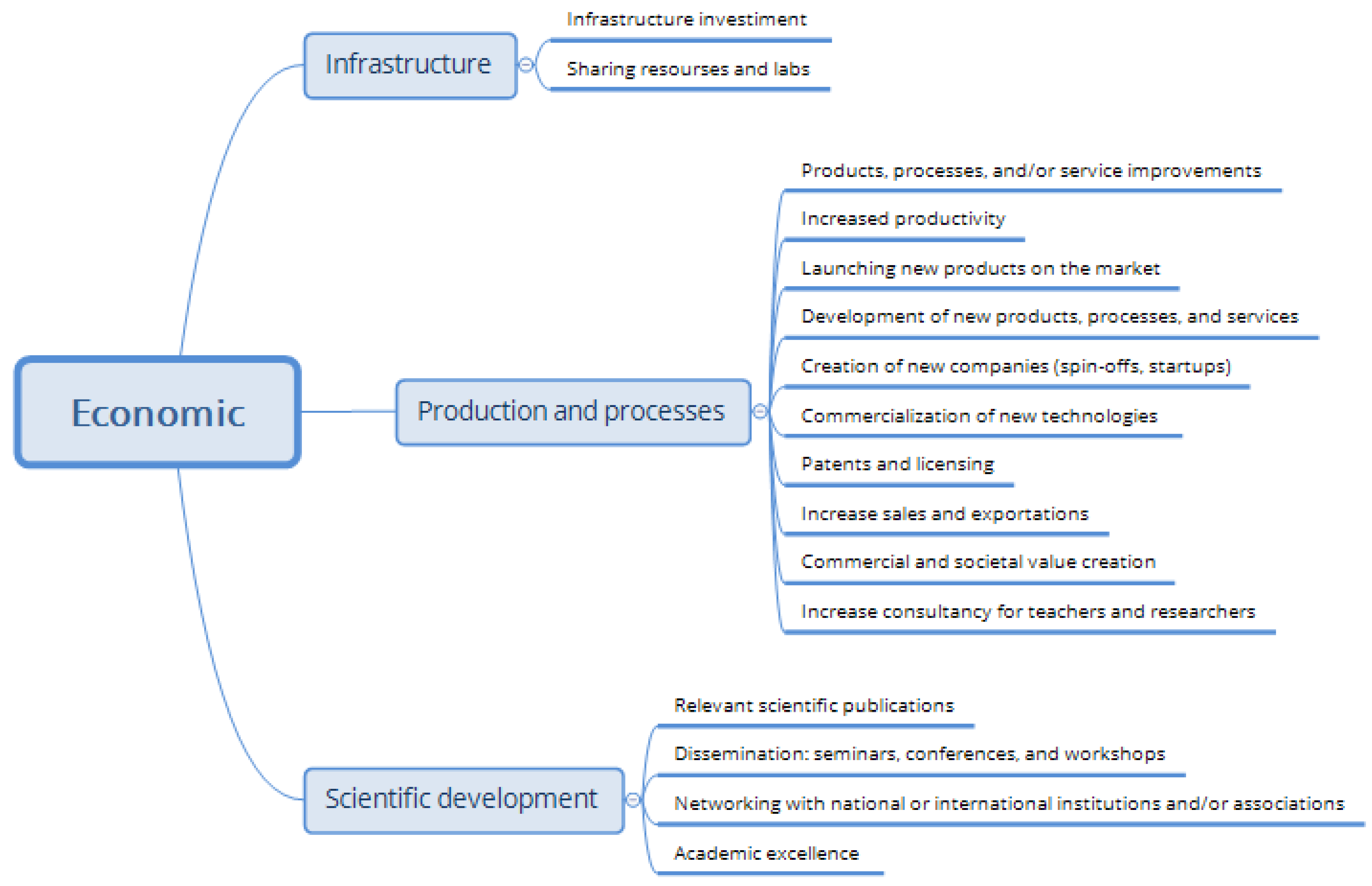
| Economic Impact | Presences | Percentage (%) |
|---|---|---|
| Infrastructure investment | 2 | 2.13% |
| Sharing resources and labs | 9 | 9.57% |
| Product, process, and/or service improvements | 4 | 4.26% |
| Increased productivity | 8 | 8.51% |
| Launching new products on the market | 1 | 1.06% |
| Development of new products, processes, and services | 4 | 4.26% |
| Creation of new companies | 10 | 10.64% |
| Creation of spin-offs | 27 | 28.72% |
| Creation of startups | 13 | 13.83% |
| Commercialization of new technologies | 8 | 8.51% |
| Patents and licensing | 54 | 57.45% |
| Increased sales | 10 | 10.64% |
| Increased exportations | 2 | 2.13% |
| Commercial and societal value creation | 2 | 2.13% |
| Increased consultancy for professors and researchers | 17 | 18.09% |
| Relevant scientific publications | 23 | 24.47% |
| Dissemination: seminars, conferences, and workshops | 10 | 10.64% |
| Networking with national or international institutions and/or associations | 5 | 5.32% |
| Academic excellence | 2 | 2.13% |
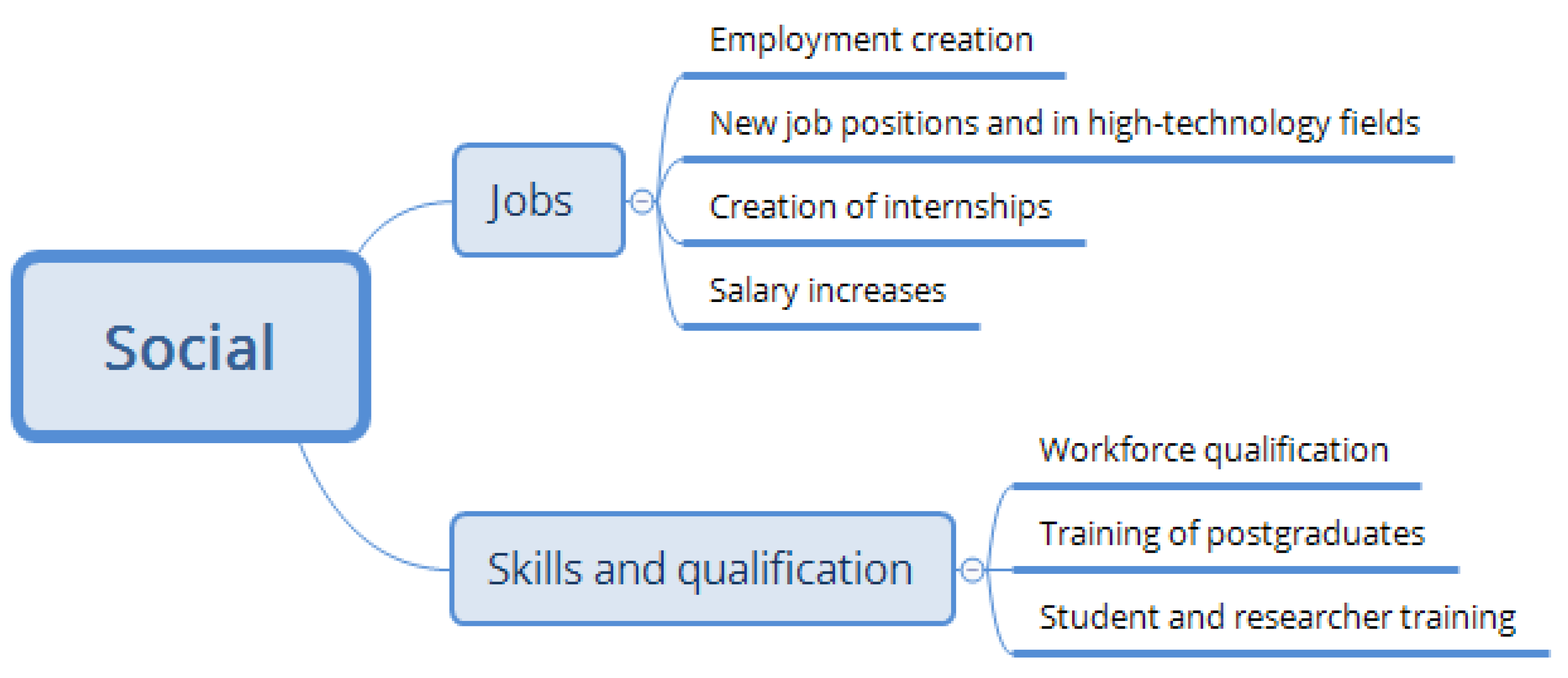
| Social Impact | Presences | Percentage |
|---|---|---|
| Employment creation | 40 | 42.55% |
| New job positions and in high-technology fields | 7 | 7.45% |
| Creation of internships | 3 | 3.19% |
| Salary increases | 1 | 1.06% |
| Workforce qualification | 7 | 7.45% |
| Training of postgraduates | 1 | 1.06% |
| Student and researcher training | 4 | 4.26% |

| Financial Impact | Presences | Percentage |
|---|---|---|
| Good and services acquisition from national and local suppliers | 1 | 1.06% |
| Tax generation | 4 | 4.26% |
| Investments | 11 | 11.70% |
| Financing | 9 | 9.57% |
| Firm revenue | 1 | 1.06% |
| Firm profits | 7 | 7.45% |
| University revenues | 3 | 3.19% |
| Higher GDP and GDP per capita | 13 | 13.83% |
References
- Berbegal-Mirabent, J.; García, J.L.S.; Ribeiro-Soriano, D.E. University–industry partnerships for the provision of R&D services. J. Bus. Res. 2015, 68, 1407–1413. [Google Scholar] [CrossRef]
- Chesbrough, H.; Vanhaverbeke, W.; West, J. Open Innovation: Researching a New Paradigm, 1st ed.; Oxford University Press: New York, NY, USA, 2006; pp. 1–373. [Google Scholar]
- Etzkowitz, H.; de Mello, J.M.C.; Almeida, M. Towards “meta-innovation” in Brazil: The evolution of the incubator and the emergence of a triple helix. Res. Policy 2005, 34, 411–424. [Google Scholar] [CrossRef]
- Etzkowitz, H.; Zhou, C. Triple Helix twins: Innovation and sustainability. Sci. Public Policy 2006, 33, 77–83. [Google Scholar] [CrossRef]
- Galan-Muros, V.; Davey, T. The UBC ecosystem: Putting together a comprehensive framework for university-business cooperation. J. Technol. Transf. 2019, 44, 1311–1346. [Google Scholar] [CrossRef]
- Audretsch, D.B.; Cunningham, J.A.; Kuratko, D.F.; Lehmann, E.E.; Menter, M. Entrepreneurial ecosystems: Economic, technological, and societal impacts. J. Technol. Transf. 2019, 44, 313–325. [Google Scholar] [CrossRef]
- Etzkowitz, H.; Webster, A.; Gebhardt, C.; Terra, B.R.C. The future of the university and the university of the future: Evolution of ivory tower to entrepreneurial paradigm. Res. Policy 2000, 29, 313–330. [Google Scholar] [CrossRef]
- Alessandrini, M.; Klose, K.; Pepper, M.S. University entrepreneurship in South Africa: Developments in technology transfer practices. Innovation 2013, 15, 205–214. [Google Scholar] [CrossRef]
- Bercovitz, J.; Feldman, M. Entrepreneurial universities and technology transfer: A conceptual framework for understanding knowledge-based economic development. J. Technol. Transf. 2006, 31, 175–188. [Google Scholar] [CrossRef]
- Etzkowitz, H.; Bikkulov, A.; Kovaleinen, A.; Leitner, K.H.; Poutanen, S.; Gray, D.; Leonchuck, L.; Axelberg, J.; Plonski, G.A.; Almeida, M.; et al. Metrics for the entrepreneurial university [GEUM white paper]. In Triple Helix Working Papers Series; WPS 1; Triple Helix Association: Roma, Italy, 2017; Available online: https://www.triplehelixassociation.org/download/metrics-for-the-entrepreneurial-university (accessed on 1 April 2021).
- Bryman, A.; Bell, E. Business Research Methods, 3rd ed.; Oxford University Press: New York, NY, USA, 2011; pp. 1–765. [Google Scholar]
- Tranfield, D.; Denyer, D.; Smart, P. Towards a methodology for developing evidence-informed management knowledge by means of systematic review. Br. J. Manag. 2003, 14, 207–222. [Google Scholar] [CrossRef]
- Fink, A. Conducting Research Literature Reviews: From the Internet to Paper, 4th ed.; SAGE Publications: Newbury Park, CA, USA, 2013; pp. 1–280. [Google Scholar]
- Denyer, D.; Tranfield, D.; Van Aken, J.E. Developing design propositions through research synthesis. Organ. Stud. 2008, 29, 393–413. [Google Scholar] [CrossRef]
- Ramakrishnan, M.; Shrestha, A.; Soar, J. Innovation centric knowledge commons—A systematic literature review and conceptual model. J. Open Innov. 2021, 7, 35. [Google Scholar] [CrossRef]
- Crișan, E.L.; Salanță, I.I.; Beleiu, I.N.; Bordean, O.N.; Bunduchi, R. A systematic literature review on accelerators. J. Technol. Transf. 2021, 46, 62–89. [Google Scholar] [CrossRef]
- Okoli, C.; Schabram, K.A. Guide to conducting a systematic literature review of information systems research. Sprouts Work. Papers Infor. Syst. 2010, 10, 1–50. Available online: http://sprouts.aisnet.org/10-26 (accessed on 10 April 2020). [CrossRef]
- Iden, J.; Methlie, L.B.; Christensen, G.E. The nature of strategic foresight research: A systematic literature review. Technol. Forecast. Soc. Chang. 2017, 116, 87–97. [Google Scholar] [CrossRef]
- Breznitz, S.M.; Feldman, M.P. The engaged university. J. Technol. Transf. 2012, 37, 139–157. [Google Scholar] [CrossRef]
- Budyldina, N. Entrepreneurial universities and regional contribution. Int. Entrep. Manag. J. 2018, 14, 265–277. [Google Scholar] [CrossRef]
- Etzkowitz, H. Anatomy of the entrepreneurial university. Soc. Sci. Inf. 2013, 52, 486–511. [Google Scholar] [CrossRef]
- Philbin, S. Measuring the performance of research collaborations. Meas. Bus. Excell. 2008, 12, 16–23. [Google Scholar] [CrossRef]
- Barge-Gil, A.; Modrego, A. The impact of research and technology organizations on firm competitiveness. Measurement and determinants. J. Technol. Transf. 2011, 36, 61–83. [Google Scholar] [CrossRef]
- Doh, S.; Kim, B. Government support for SME innovations in the regional industries: The case of government financial support program in South Korea. Res. Policy 2014, 43, 1557–1569. [Google Scholar] [CrossRef]
- Bramwell, A.; Wolfe, D.A. Universities and regional economic development: The entrepreneurial University of Waterloo. Res. Policy 2008, 37, 1175–1187. [Google Scholar] [CrossRef]
- Lendel, I. The impact of research universities on regional economies: The concept of university products. Econ. Dev. Q. 2010, 24, 210–230. [Google Scholar] [CrossRef]
- Coronado, D.; Flores, E.; Martínez, M.Á. The role of regional economic specialization in the production of university-owned patents. Ann. Reg. Sci. 2017, 59, 513–533. [Google Scholar] [CrossRef]
- Ahrweiler, P.; Pyka, A.; Gilbert, N. A new model for university-industry links in knowledge-based economies. J. Prod. Innov. Manag. 2011, 28, 218–235. [Google Scholar] [CrossRef]
- Audretsch, D.B.; Leyden, D.P.; Link, A.N. Regional appropriation of university-based knowledge and technology for economic development. Econ. Dev. Q. 2013, 27, 56–61. [Google Scholar] [CrossRef]
- Bradley, S.R.; Hayter, C.S.; Link, A.N. Proof of concept centers in the United States: An exploratory look. J. Technol. Transf. 2013, 38, 349–381. [Google Scholar] [CrossRef]
- Pawson, R.; Tilley, N. Realistic Evaluation, 1st ed.; SAGE Publications: Newbury Park, CA, USA, 1997; pp. 1–254. [Google Scholar]
- Dutrénit, G.; Arza, V. Channels and benefits of interactions between public research organisations and industry: Comparing four Latin American countries. Sci. Public Policy 2010, 37, 541–553. [Google Scholar] [CrossRef]
- Perkmann, M.; Fini, R.; Ross, J.M.; Salter, A.; Silvestri, C.; Tartari, V. Accounting for universities’ impact: Using augmented data to measure academic engagement and commercialization by academic scientists. Res. Eval. 2015, 24, 380–391. [Google Scholar] [CrossRef]
- Hope, A. Creating sustainable cities through knowledge exchange: A case study of knowledge transfer partnerships. Int. J. Sustain. High. Educ. 2016, 17, 796–811. [Google Scholar] [CrossRef]
- Lendel, I.; Qian, H. Inside the great recession: University products and regional economic development. Growth Chang. 2017, 48, 153–173. [Google Scholar] [CrossRef]
- Azagra-Caro, J.M.; Barberá-Tomás, D.; Edwards-Schachter, M.; Tur, E.M. Dynamic interactions between university–industry knowledge transfer channels: A case study of the most highly cited academic patent. Res. Policy 2017, 46, 463–474. [Google Scholar] [CrossRef]
- Kochetkov, D.M.; Larionova, V.A.; Vukovic, D.B. Entrepreneurial capacity of universities and its impact on regional economic growth. Econ. Reg. 2017, 13, 477–488. [Google Scholar] [CrossRef]
- Owusu-Agyeman, Y.; Fourie-Malherbe, M. Workforce development and higher education in Ghana: A symmetrical relationship between industry and higher education institutions. Ind. High. Educ. 2019, 33, 425–438. [Google Scholar] [CrossRef]
- Mets, T.; Kelli, A.; Mets, A.; Tiimann, T. From patent counting towards the system of IP strategic indicators. Eng. Econ. 2016, 27, 316–324. [Google Scholar] [CrossRef]
- Jones, J.; de Zubielqui, G.C. Doing well by doing good: A study of university–industry interactions, innovationess and firm performance in sustainability-oriented Australian SMEs. Technol. Forecast. Soc. Chang. 2017, 123, 262–270. [Google Scholar] [CrossRef]
- Secundo, G.; Perez, S.E.; Martinaitis, Ž.; Leitner, K.H. An intellectual capital framework to measure universities’ third mission activities. Technol. Forecast. Soc. Chang. 2017, 123, 229–239. [Google Scholar] [CrossRef]
- Chiesa, V.; Piccaluga, A. Exploitation and diffusion of public research: The case of academic spin-off companies in Italy. R D Manag. 2000, 30, 329–340. [Google Scholar] [CrossRef]
- Guadix, J.; Carrillo-Castrillo, J.; Onieva, L.; Navascues, J. Success variables in science and technology parks. J. Bus. Res. 2016, 69, 4870–4875. [Google Scholar] [CrossRef]
- O’Shea, R.P.; Chugh, H.; Allen, T.J. Determinants and consequences of university spinoff activity: A conceptual framework. J. Technol. Transf. 2008, 33, 653–666. [Google Scholar] [CrossRef]
- Piirainen, K.A.; Andersen, A.D.; Andersen, P.D. Foresight and the third mission of universities: The case for innovation system foresight. Foresight 2016, 18, 24–40. [Google Scholar] [CrossRef]
- Ramos-Vielba, I.; Fernández-Esquinas, M. Beneath the tip of the iceberg: Exploring the multiple forms of university–industry linkages. High. Educ. 2012, 64, 237–265. [Google Scholar] [CrossRef]
- Olmos-Peñuela, J.; Castro-Martínez, E.; D’Este, P. Knowledge transfer activities in social sciences and humanities: Explaining the interactions of research groups with non-academic agents. Res. Policy 2014, 43, 696–706. [Google Scholar] [CrossRef]
- Macpherson, A.; Ziolkowski, M. The role of university-based industrial extension services in the business performance of small manufacturing firms: Case-study evidence from Western New York. Entrep. Reg. Dev. 2005, 17, 431–447. [Google Scholar] [CrossRef]
- Steffensen, M.; Rogers, E.M.; Speakman, K. Spin-offs from research centers at a research university. J. Bus. Ventur. 2000, 15, 93–111. [Google Scholar] [CrossRef]
- Urbano, D.; Guerrero, M. Entrepreneurial universities: Socioeconomic impacts of academic entrepreneurship in a European region. Econ. Dev. Q. 2013, 27, 40–55. [Google Scholar] [CrossRef]
- Chen, F.; Wu, C.; Yang, W. A new approach for the cooperation between academia and industry: An empirical analysis of the triple helix in East China. Sci. Technol. Soc. 2016, 21, 181–204. [Google Scholar] [CrossRef]
- Holley, K.A.; Harris, M.S. “The 400-pound gorilla”: The role of the research university in city development. Innov. High. Educ. 2018, 43, 77–90. [Google Scholar] [CrossRef]
- Kourtit, K.; Nijkamp, P.; Van Vught, F. Clusters of supernova stars in knowledge-based spaces: Value creation through cooperation. Int. J. Glob. Environ. Issues 2014, 13, 235–257. [Google Scholar] [CrossRef]
- Orozco, J.; Ruiz, K. Quality of interactions between public research organisations and firms: Lessons from Costa Rica. Sci. Public Policy 2010, 37, 527–540. [Google Scholar] [CrossRef]
- Fernandes, A.C.; De Souza, B.C.; Da Silva, A.S.; Suzigan, W.; Chaves, C.V.; Albuquerque, E. Academy–industry links in Brazil: Evidence about channels and benefits for firms and researchers. Sci. Public Policy 2010, 37, 485–498. [Google Scholar] [CrossRef]
- Hayter, C.S.; Link, A.N. On the economic impact of university proof of concept centers. J. Technol. Transf. 2015, 40, 178–183. [Google Scholar] [CrossRef]
- Chang, Y.-C.; Chen, M.-H.; Hua, M.; Yang, P.Y. Managing academic innovation in Taiwan: Towards a “scientific–economic” framework. Technol. Forecast. Soc. Chang. 2006, 73, 199–213. [Google Scholar] [CrossRef]
- Smith, H.L.; Bagchi-Sen, S. The research university, entrepreneurship and regional development: Research propositions and current evidence. Entrep. Reg. Dev. 2012, 24, 383–404. [Google Scholar] [CrossRef]
- Etzkowitz, H.; Leydesdorff, L. The dynamics of innovation: From national systems and “mode 2” to a triple helix of university–industry–government relations. Res. Policy 2000, 29, 109–123. [Google Scholar] [CrossRef]
- Aparicio, S.; Urbano, D.; Gómez, D. The role of innovative entrepreneurship within Colombian business cycle scenarios: A system dynamics approach. Futures 2016, 81, 130–147. [Google Scholar] [CrossRef]
- Azagra-Caro, J.M.; Tijssen, R.J.; Tur, E.M.; Yegros-Yegros, A. University–industry scientific production and the Great Recession. Technol. Forecast. Soc. Chang. 2019, 139, 210–220. [Google Scholar] [CrossRef]
- Baskaran, A.; Chandran, V.G.R.; Ng, B.K. Inclusive entrepreneurship, innovation and sustainable growth: Role of business incubators, academia and social enterprises in Asia. Sci. Technol. Soc. 2019, 24, 385–400. [Google Scholar] [CrossRef]
- Carayannis, E.G.; Cherepovitsyn, A.E.; Ilinova, A.A. Sustainable development of the Russian Arctic zone energy shelf: The role of the quintuple innovation helix model. J. Knowl. Econ. 2017, 8, 456–470. [Google Scholar] [CrossRef]
- Carlsson, B.; Acs, Z.J.; Audrersch, D.B.; Braunerhjelm, P. Knowledge creation, entrepreneurship, and economic growth: A historical review. Ind. Corp. Chang. 2009, 18, 1193–1229. [Google Scholar] [CrossRef]
- Cheshire, P.; Magrini, S. Endogenous processes in European regional growth: Convergence and policy. Growth Chang. 2000, 31, 455–479. [Google Scholar] [CrossRef]
- Civera, A.; Meoli, M.; Vismara, S. Do academic spinoffs internationalize? J. Technol. Transf. 2019, 44, 381–403. [Google Scholar] [CrossRef]
- Dalmarco, G.; Hulsink, W.; Blois, G.V. Creating entrepreneurial universities in an emerging economy: Evidence from Brazil. Technol. Forecast. Soc. Chang. 2018, 135, 99–111. [Google Scholar] [CrossRef]
- Dill, D.D. University-industry entrepreneurship: The organization and management of American university technology transfer units. High. Educ. 1995, 29, 369–384. [Google Scholar] [CrossRef]
- Fadeyi, O.; Maresova, P.; Stemberkova, R.; Afolayan, M.; Adeoye, F. Perspectives of university–industry technology transfer in African emerging economies: Evaluating the Nigerian scenario via a data envelopment approach. Soc. Sci. 2019, 8, 286. [Google Scholar] [CrossRef]
- Farinha, L.; Ferreira, J.; Gouveia, B. Networks of innovation and competitiveness: A triple helix case study. J. Knowl. Econ. 2016, 7, 259–275. [Google Scholar] [CrossRef]
- Fischer, B.B.; Schaeffer, P.R.; Silveira, J.P. Universities’ gravitational effects on the location of knowledge-intensive investments in Brazil. Sci. Public Policy 2018, 45, 692–707. [Google Scholar] [CrossRef]
- Gjelsvik, M. Universities, innovation and competitiveness in regional economies. Int. J. Technol. Manag. 2018, 76, 10–31. [Google Scholar] [CrossRef]
- Guerrero, M.; Urbano, D.; Fayolle, A. Entrepreneurial activity and regional competitiveness: Evidence from European entrepreneurial universities. J. Technol. Transf. 2016, 41, 105–131. [Google Scholar] [CrossRef]
- Handoko, F.; Smith, A.; Burvill, C. The role of government, universities, and businesses in advancing technology for SMEs’ innovativeness. J. Chin. Econ. Bus. Stud. 2014, 12, 171–180. [Google Scholar] [CrossRef]
- Hayter, C.S. Harnessing university entrepreneurship for economic growth: Factors of success among university spin-offs. Econ. Dev. Q. 2013, 27, 18–28. [Google Scholar] [CrossRef]
- Hearn, G.; Cunningham, S.; Ordonez, D. Commercialisation of knowledge in universities: The case of the creative industries. Prometheus 2004, 22, 189–200. [Google Scholar] [CrossRef]
- Hooi, R.; Wang, J. Research funding and academic engagement: A Singapore case. Knowl. Manag. Res. Pract. 2019, 18, 162–174. [Google Scholar] [CrossRef]
- Iacobucci, D.; Micozzi, A. How to evaluate the impact of academic spin-offs on local development: An empirical analysis of the Italian case. J. Technol. Transf. 2015, 40, 434–452. [Google Scholar] [CrossRef]
- Jones-Evans, D.; Klofsten, M.; Andersson, E.; Pandya, D. Creating a bridge between university and industry in small European countries: The role of the Industrial Liaison Office. R D Manag. 1999, 29, 47–56. [Google Scholar] [CrossRef]
- Kalantaridis, C. Is university ownership a sub-optimal property rights regime for commercialisation? Information conditions and entrepreneurship in Greater Manchester, England. J. Technol. Transf. 2019, 44, 231–249. [Google Scholar] [CrossRef]
- Kim, Y.; Kim, W.; Yang, T. The effect of the triple helix system and habitat on regional entrepreneurship: Empirical evidence from the US. Res. Policy 2012, 41, 154–166. [Google Scholar] [CrossRef]
- Klofsten, M.; Fayolle, A.; Guerrero, M.; Mian, S.; Urbano, D.; Wright, M. The entrepreneurial university as driver for economic growth and social change: Key strategic challenges. Technol. Forecast. Soc. Chang. 2019, 141, 149–158. [Google Scholar] [CrossRef]
- Langford, C.H.; Hall, J.; Josty, P.; Matos, S.; Jacobson, A. Indicators and outcomes of Canadian university research: Proxies becoming goals? Res. Policy 2006, 35, 1586–1598. [Google Scholar] [CrossRef]
- Lee, S.J. Academic entrepreneurship: Exploring the effects of academic patenting activity on publication and collaboration among heterogeneous researchers in South Korea. J. Technol. Transf. 2019, 44, 1993–2013. [Google Scholar] [CrossRef]
- Lehmann, E.E.; Menter, M. University–industry collaboration and regional wealth. J. Technol. Transf. 2016, 41, 1284–1307. [Google Scholar] [CrossRef]
- Lehmann, E.E.; Menter, M. Public cluster policy and performance. J. Technol. Transf. 2017, 43, 558–592. [Google Scholar] [CrossRef]
- Lin, J.Y. How does collaboration between universities and R&D firms influence performance? Manag. Decis. 2019, 57, 2436–2476. [Google Scholar] [CrossRef]
- Looy, B.V.; Debackere, K.; Andries, P. Policies to stimulate regional innovation capabilities via university–industry collaboration: An analysis and an assessment. R D Manag. 2003, 33, 209–229. [Google Scholar] [CrossRef]
- Mariani, G.; Carlesi, A.; Scarfò, A.A. Academic spinoffs as a value driver for intellectual capital: The case of the University of Pisa. J. Intellect. Cap. 2018, 19, 202–226. [Google Scholar] [CrossRef]
- Mascarenhas, C.; Marques, C.S.; Galvão, A.R.; Carlucci, D.; Falcão, P.F.; Ferreira, F.A. Analyzing technology transfer offices’ influence for entrepreneurial universities in Portugal. Manag. Decis. 2019, 57, 3473–3491. [Google Scholar] [CrossRef]
- McCullough, J.M. Technology transfer: Creating the right environment. Ind. High. Educ. 2003, 17, 111–117. [Google Scholar] [CrossRef]
- Ndonzuau, F.N.; Pirnay, F.; Surlemont, B. A stage model of academic spin-off creation. Technovation 2002, 22, 281–289. [Google Scholar] [CrossRef]
- Núñez-Sánchez, R.; Barge-Gil, A.; Modrego-Rico, A. Performance of knowledge interactions between public research centres and industrial firms in Spain: A project-level analysis. J. Technol. Transf. 2012, 37, 330–354. [Google Scholar] [CrossRef]
- Onken, J.; Aragon, R.; Calcagno, A.M. Geographically related outcomes of US funding for small business research and development: Results of the research grant programs of a component of the National Institutes of Health. Eval. Program. Plann. 2019, 77, 101696. [Google Scholar] [CrossRef]
- Raguž, M.J.; Mehičić, N.M. The influence of science–industry collaboration on firms’ innovative performance–evidence from the Republic of Croatia. Econ. Res. Ekon. Istraz. 2017, 30, 992–1002. [Google Scholar] [CrossRef]
- Ratinho, T.; Henriques, E. The role of science parks and business incubators in converging countries: Evidence from Portugal. Technovation 2010, 30, 278–290. [Google Scholar] [CrossRef]
- Roessner, D.; Bond, J.; Okubo, S.; Planting, M. The economic impact of licensed commercialized inventions originating in university research. Res. Policy 2013, 42, 23–34. [Google Scholar] [CrossRef]
- Sá, E.; Casais, B.; Silva, J. Local development through rural entrepreneurship, from the Triple Helix perspective. Int. J. Entrep. Behav. Res. 2019, 25, 698–716. [Google Scholar] [CrossRef]
- Sánchez-Barrioluengo, M.; Benneworth, P. Is the entrepreneurial university also regionally engaged? Analysing the influence of university’s structural configuration on third mission performance. Technol. Forecast. Soc. Chang. 2019, 141, 206–218. [Google Scholar] [CrossRef]
- Sherman, H.; Chappell, D.S. Methodological challenges in evaluating business incubator outcomes. Econ. Dev. Q. 1998, 12, 313–321. [Google Scholar] [CrossRef]
- Sizer, J. Research and the knowledge age. Tert. Educ. Manag. 2001, 7, 227–242. [Google Scholar] [CrossRef]
- Smith, H.L. Knowledge organizations and local economic development: The cases of Oxford and Grenoble. Reg. Stud. 2003, 37, 899–909. [Google Scholar] [CrossRef]
- Van Geenhuizen, M.; Soetanto, D.; Nijkamp, P. Diversity as a critical element in stimulating the role of technical universities in the regional economy. Stud. Reg. Sci. 2007, 37, 501–518. [Google Scholar] [CrossRef][Green Version]
- Varga, A. Local academic knowledge transfers and the concentration of economic activity. J. Reg. Sci. 2000, 40, 289–309. [Google Scholar] [CrossRef]
- Villasana, M. Fostering university–industry interactions under a triple helix model: The case of Nuevo Leon, Mexico. Sci. Public Policy 2011, 38, 43–53. [Google Scholar] [CrossRef]
- Vincett, P.S. The economic impacts of academic spin-off companies, and their implications for public policy. Res. Policy 2010, 39, 736–747. [Google Scholar] [CrossRef]
- Wakkee, I.; van der Sijde, P.; Vaupell, C.; Ghuman, K. The university’s role in sustainable development: Activating entrepreneurial scholars as agents of change. Technol. Forecast. Soc. Chang. 2019, 141, 195–205. [Google Scholar] [CrossRef]
- Wen, J.; Kobayashi, S. Exploring collaborative R&D network: Some new evidence in Japan. Res. Policy 2001, 30, 1309–1319. [Google Scholar] [CrossRef]
- Zucker, L.G.; Darby, M.R. Capturing technological opportunity via Japan’s star scientists: Evidence from Japanese firms’ biotech patents and products. J. Technol. Transf. 2001, 26, 37–58. [Google Scholar] [CrossRef]
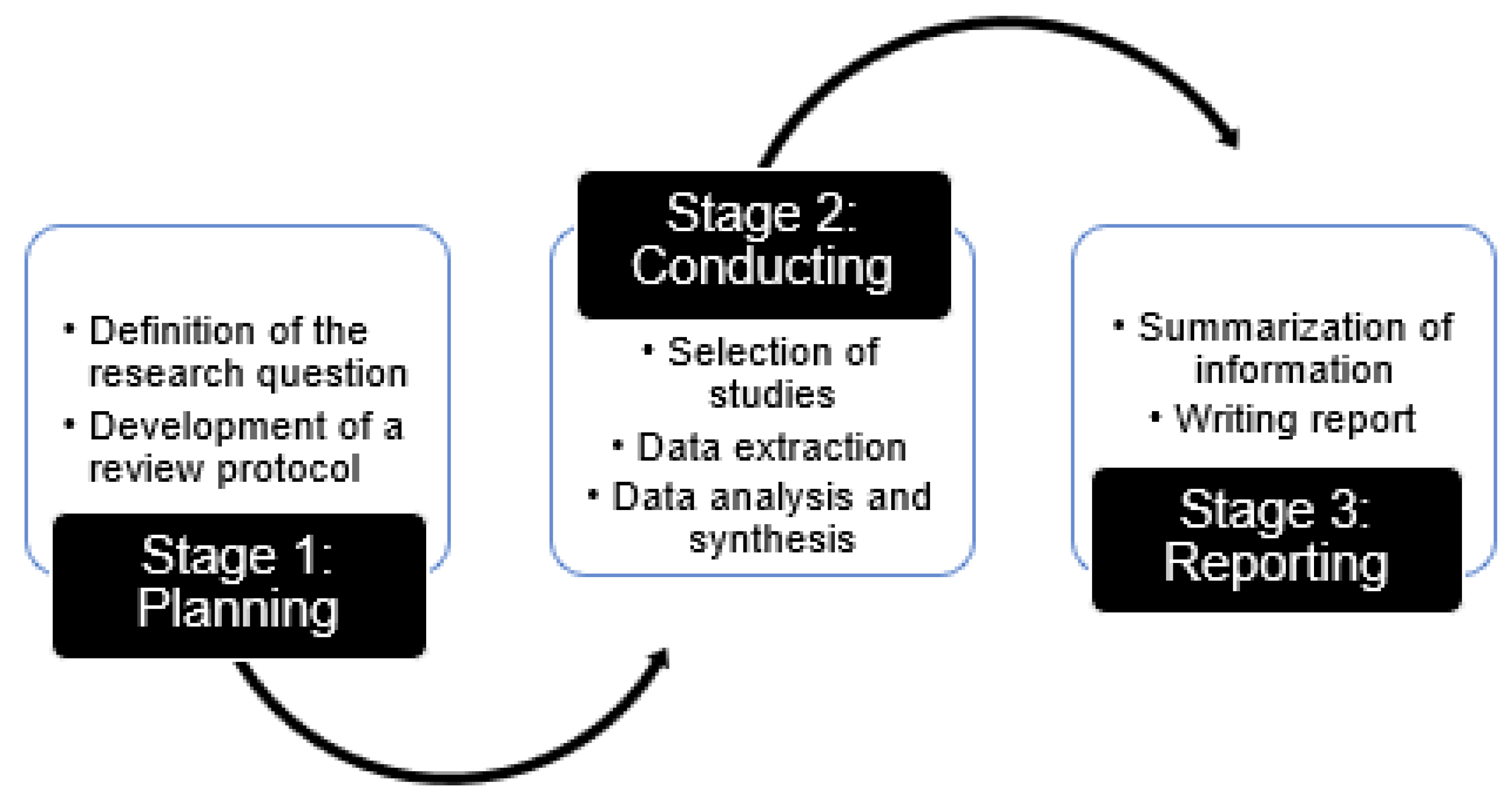
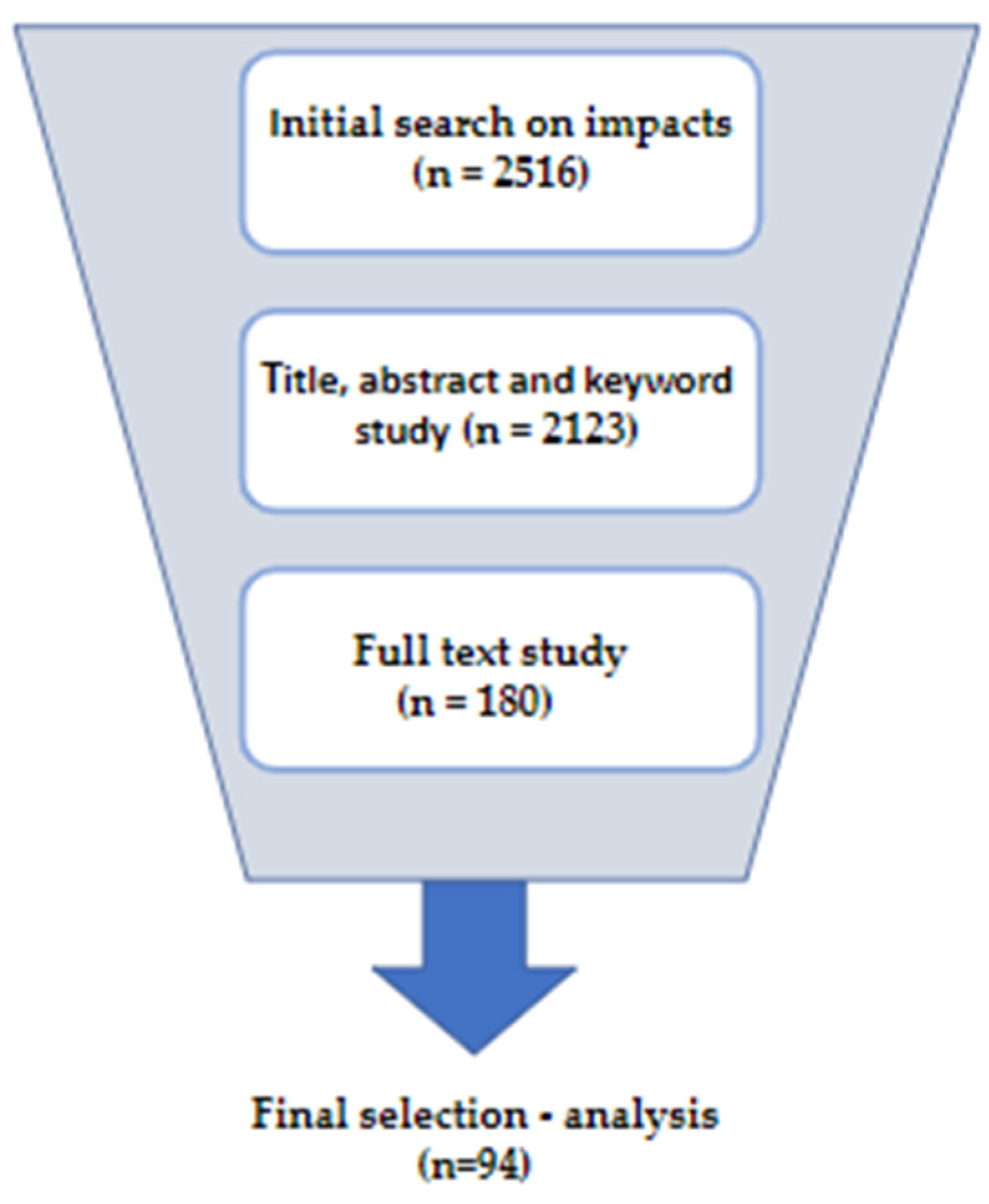
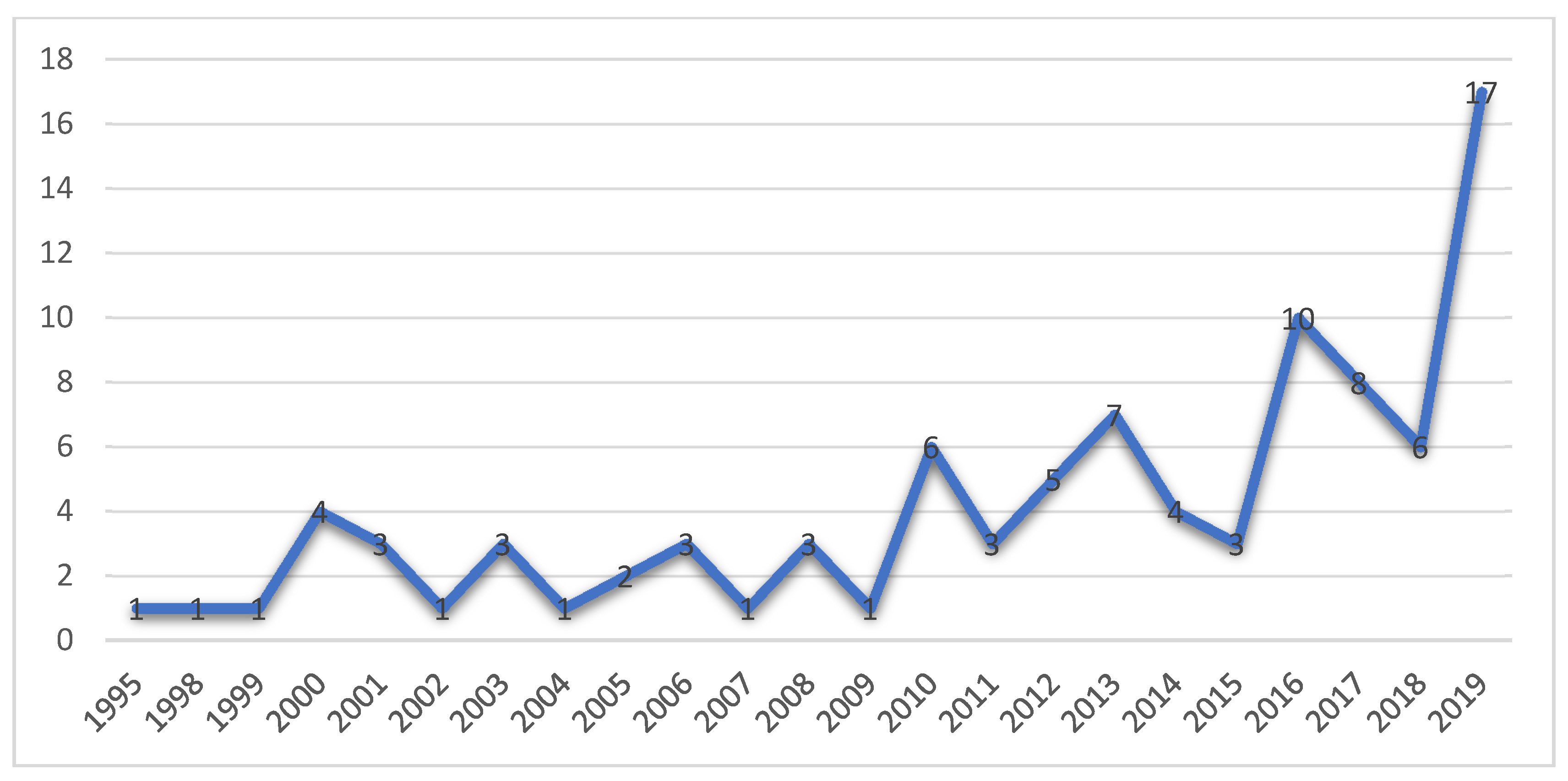
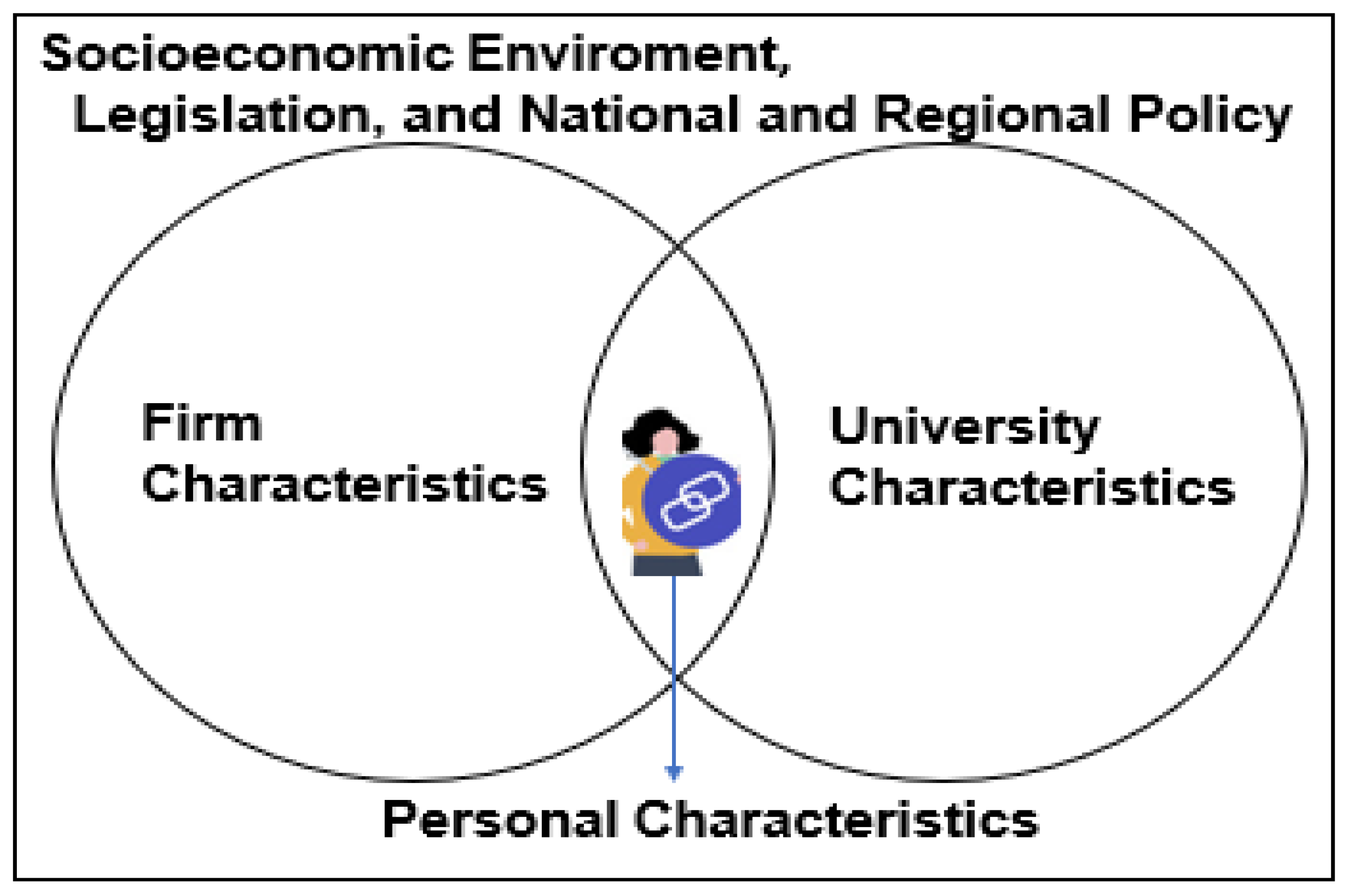
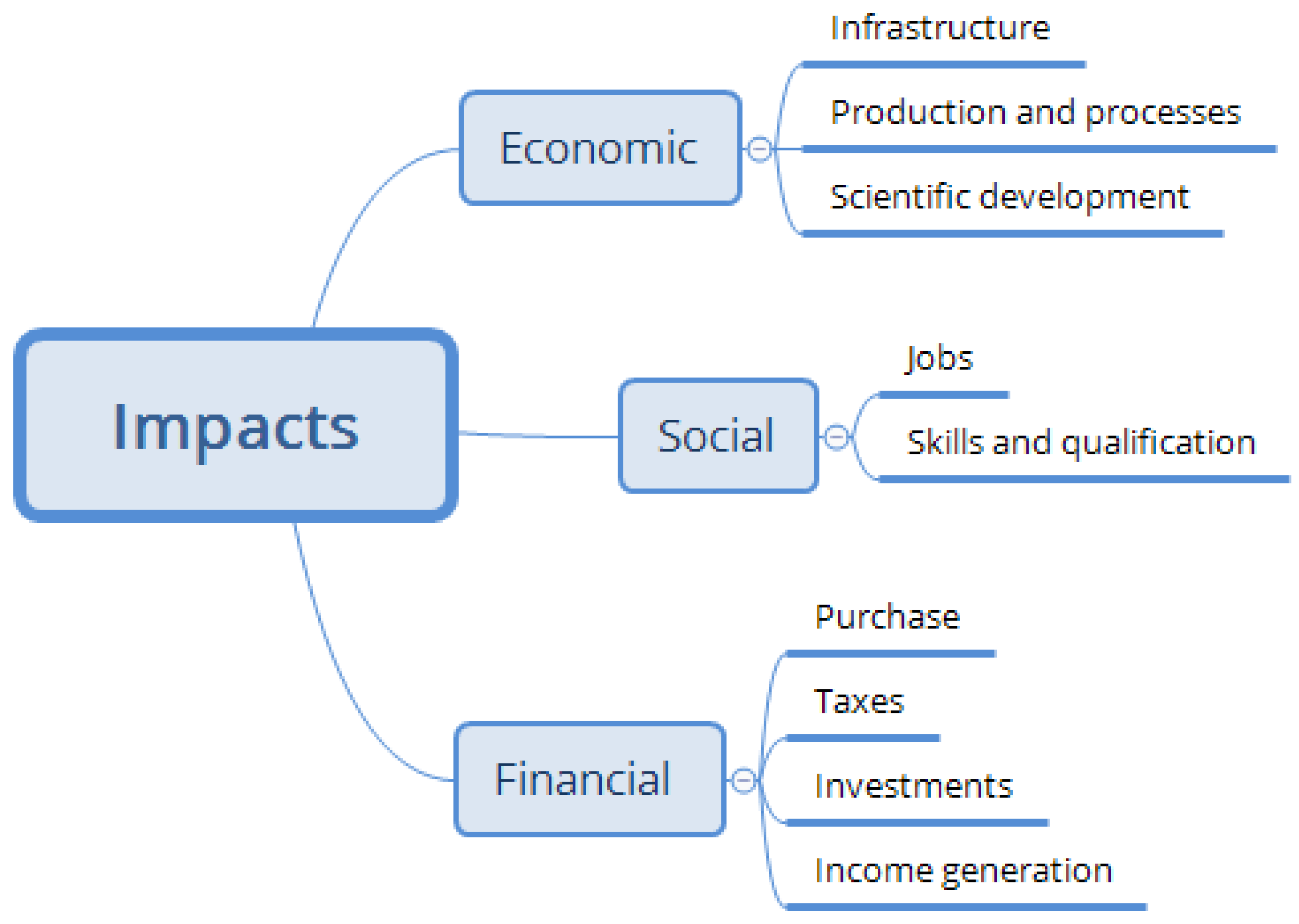
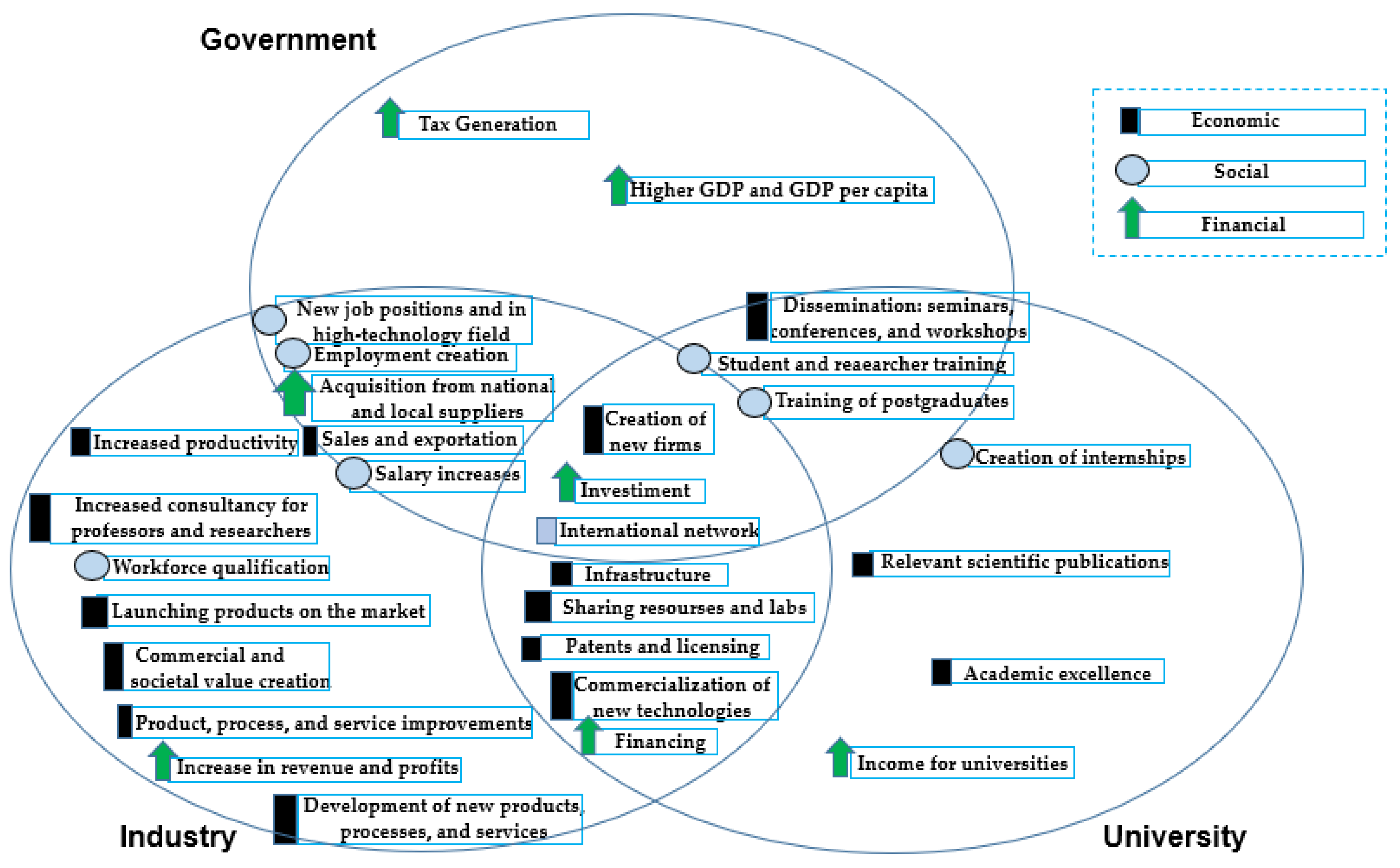
| Steps | Description |
|---|---|
| Research question definition | What are the direct socioeconomic impacts of university–industry collaborations? |
| Keywords definition | (“knowledge transfer” or “technology transfer” or “collaboration” or “contract” or “interaction”) and (“university” or “academic” or “faculty”) and (“social” or “economic” or “socioeconomic”) and (“growth” or “impact” or “effect” or “development” or “spillover” or “progress” or “sustainability”) and (“firm” or “business” or “company” or “industry” or “corporation” or “establishment” or “organization” or “enterprise”) |
| Definition of databases | Web of Science and Scopus |
| Articles’ inclusion/exclusion criteria | Main selection criterion: adherence of the article to the topic “University–industry collaboration” • Checking the title, abstract, and keywords, and if necessary, a more in-depth reading of the text • Inclusion criteria: only articles mentioning the socioeconomic impacts of the university–industry collaboration and that present resulting impacts • Articles in English • Articles published in peer-reviewed journals • Main exclusion criterion: Articles published in congress proceedings, book chapters, theses or dissertations, newspaper reports, opinion pieces, and other similar papers • Exclusion of duplicated articles • Exclusion of articles that are studies in progress/unfinished • Exclusion of articles that do not meet the other inclusion criteria |
| Data extraction | • Authors • Journal • Country • Year • Nature of the study (if conceptual or empirical research, if it follows a qualitative or quantitative method or analysis) • Socioeconomic impact |
| Analysis and synthesis | • Use of StArt for the selection of articles in the systematic review • Use of NVivo for data management and content analysis • Data summary: Descriptive statistics and content analysis • CIMO analysis |
| Journal | Number | Percentage (%) |
|---|---|---|
| Journal of Technology Transfer | 18 | 19.15 |
| Research Policy | 9 | 9.57 |
| Technological Forecasting & Social Change | 8 | 8.51 |
| Science and Public Policy | 5 | 5.32 |
| Economic Development Quartely | 5 | 5.32 |
| R&D Management | 3 | 3.19 |
| Entrepreneurship & Regional Development: An International Journal | 2 | 2.13 |
| Growth and Change | 2 | 2.13 |
| Higher Education | 2 | 2.13 |
| Industry & Higher Education | 2 | 2.13 |
| Journal of the Knowledge Economy | 2 | 2.13 |
| Management Decision | 2 | 2.13 |
| Science, Technology & Society | 2 | 2.13 |
| Technovation | 2 | 2.13 |
| Economy of Region | 1 | 1.06 |
| Economic Research | 1 | 1.06 |
| Engineering Economics | 1 | 1.06 |
| Evaluation and Program Planning | 1 | 1.06 |
| Foresight | 1 | 1.06 |
| Futures | 1 | 1.06 |
| Industrial and Corporate Change | 1 | 1.06 |
| Innovation | 1 | 1.06 |
| Innovative Higher Education | 1 | 1.06 |
| International Entrepreneurship and Management Journal | 1 | 1.06 |
| International Journal of Entrepreneurial Behavior & Research | 1 | 1.06 |
| International Journal of Global Environmental Issues | 1 | 1.06 |
| International Journal of Sustainability in Higher Education | 1 | 1.06 |
| International Journal of Technology Management | 1 | 1.06 |
| Journal of Business Research | 1 | 1.06 |
| Journal of Business Venturing | 1 | 1.06 |
| Journal of Chinese Economic and Business Studies | 1 | 1.06 |
| Journal of Intellectual Capital | 1 | 1.06 |
| Journal of Product Innovation Management | 1 | 1.06 |
| Journal of Regional Science | 1 | 1.06 |
| Knowledge Management Research and Practice | 1 | 1.06 |
| Measuring Business Excellence | 1 | 1.06 |
| Prometheus: Critical Studies in Innovation | 1 | 1.06 |
| Regional Studies | 1 | 1.06 |
| Research Evaluation | 1 | 1.06 |
| Social Science | 1 | 1.06 |
| Social Science Information | 1 | 1.06 |
| Studies in Regional Science | 1 | 1.06 |
| Tertiary Education and Management | 1 | 1.06 |
| The Annals of Regional Science | 1 | 1.06 |
| Total | 94 | 100 |
| Research Method | Quantity | Percentage (%) |
|---|---|---|
| Conceptual | 9 | 9.57 |
| Empirical | 85 | 90.43 |
| Survey | 57 | 60.64 |
| Case Study | 21 | 22.34 |
| Interview | 6 | 6.38 |
| Experiment | 1 | 1.06 |
| Dominant Mechanism | Presences | Percentage % |
|---|---|---|
| Intellectual property | 18 | 19.15 |
| Spin-offs | 15 | 15.96 |
| Spin-offs and intellectual property | 15 | 15.96 |
| Hybrid organizations | 13 | 13.83 |
| Sponsored research | 11 | 11.70 |
| All mechanisms | 10 | 10.64 |
| Consulting and hiring professionals with academic knowledge | 7 | 7.47 |
| Spin-offs and hybrid organizations | 2 | 2.13 |
| Spin-offs and sponsored research | 1 | 1.06 |
| Intellectual property and hybrid organizations | 1 | 1.06 |
| Intellectual property and publications | 1 | 1.06 |
| Total | 94 | 100% |
Publisher’s Note: MDPI stays neutral with regard to jurisdictional claims in published maps and institutional affiliations. |
© 2021 by the authors. Licensee MDPI, Basel, Switzerland. This article is an open access article distributed under the terms and conditions of the Creative Commons Attribution (CC BY) license (https://creativecommons.org/licenses/by/4.0/).
Share and Cite
Lima, J.C.F.; Torkomian, A.L.V.; Pereira, S.C.F.; Oprime, P.C.; Hashiba, L.H. Socioeconomic Impacts of University–Industry Collaborations–A Systematic Review and Conceptual Model. J. Open Innov. Technol. Mark. Complex. 2021, 7, 137. https://doi.org/10.3390/joitmc7020137
Lima JCF, Torkomian ALV, Pereira SCF, Oprime PC, Hashiba LH. Socioeconomic Impacts of University–Industry Collaborations–A Systematic Review and Conceptual Model. Journal of Open Innovation: Technology, Market, and Complexity. 2021; 7(2):137. https://doi.org/10.3390/joitmc7020137
Chicago/Turabian StyleLima, João Cardim Ferreira, Ana Lúcia Vitale Torkomian, Susana Carla Farias Pereira, Pedro Carlos Oprime, and Luciana Harumi Hashiba. 2021. "Socioeconomic Impacts of University–Industry Collaborations–A Systematic Review and Conceptual Model" Journal of Open Innovation: Technology, Market, and Complexity 7, no. 2: 137. https://doi.org/10.3390/joitmc7020137
APA StyleLima, J. C. F., Torkomian, A. L. V., Pereira, S. C. F., Oprime, P. C., & Hashiba, L. H. (2021). Socioeconomic Impacts of University–Industry Collaborations–A Systematic Review and Conceptual Model. Journal of Open Innovation: Technology, Market, and Complexity, 7(2), 137. https://doi.org/10.3390/joitmc7020137





